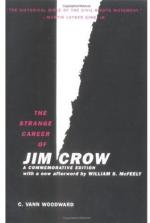
|
| Name: _________________________ | Period: ___________________ |
This test consists of 5 multiple choice questions, 5 short answer questions, and 10 short essay questions.
Multiple Choice Questions
1. One of the cases that ended the period of this change was Plessy v. _______.
(a) Bradford.
(b) Watson.
(c) Ferguson.
(d) Brown.
2. What two states were controlled by members of the KKK at this time?
(a) South Carolina and Georgia.
(b) Oklahoma and Texas.
(c) Arkansas and Virginia.
(d) Alabama and Louisiana.
3. What was the name of the landmark legislation put into effect by the president?
(a) New Deal.
(b) Gold Standard Act.
(c) Expedition Act.
(d) Interstate Commerce Act.
4. The press made headlines accusing blacks of everything from murder to ______.
(a) Avoidance.
(b) Bitterness.
(c) Conspiracy.
(d) Arrogance.
5. What type of behavior would most likely be used to ensure segregation?
(a) Argumentative.
(b) Humble.
(c) Intuitive.
(d) Aggressive.
Short Answer Questions
1. Another powerful force mentioned by the author was a movement involving black churches. What term is used to describe the movement?
2. At what college/university was there a racial riot when a black female was enrolled in classes?
3. Who was responsible for "chipping away" at the 14th Amendment in the late 1800s?
4. How many cases eventually backed up, forcing the Supreme Court to step in?
5. Which president was responsible for eliminating discrimination for federal employees?
Short Essay Questions
1. Resistance toward integration in Southern schools began to wane after what event? Which states refused to follow suit?
2. Describe the riots that took place during 1919. How many cities experienced the racial violence?
3. What input did scholars have on racism? What sections of this group were most influential in the opinion?
4. What event followed the murder of the four young girls in a black church?
5. What group of states announced that it would integrate their schools? What was the opinion of the school systems in the Deep South regarding the time line?
6. What was a major missing element in the battle for Progressive reform?
7. Name some of the reasons for the group to ease back on their efforts.
8. How did the occurrence of World War I benefit the Negro?
9. The satire that appeared in the press may have been a portent of things to come. Explain.
10. Did either party have a leader that stood up to take a strong stand on integration? What was the call put forth at the 1956 conventions?
|
This section contains 699 words (approx. 3 pages at 300 words per page) |

|




